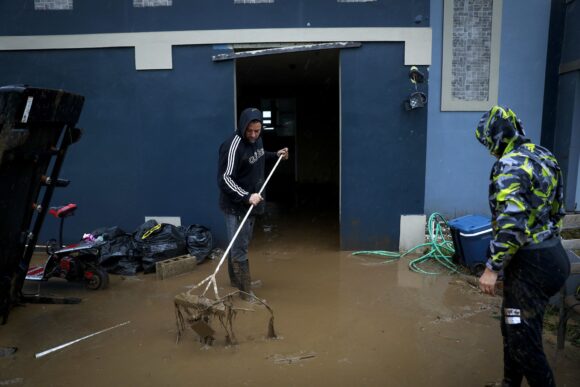Hurricane Fiona has intensified to become this year’s strongest Atlantic storm as it moves north to threaten Bermuda and eastern Canada later this week.
Fiona’s top winds remain at 130 miles (209 kilometers) per hour, according to a U.S. National Hurricane Center advisory at 2 p.m. That’s up from 85 mph when the storm knocked out power across Puerto Rico on Sunday. A Category 4 hurricane on the five-step Saffir-Simpson scale, Fiona is forecast to get even more powerful as it nears Bermuda.
The storm’s most intense winds will likely stay to the west of Bermuda, which has a sturdy building code and should be able to weather Fiona, said Adam Douty, a meteorologist with AccuWeather Inc. A tropical storm warning and hurricane watch have been issued for the island.
Hurricane Fiona Moves North With Up to $4B Economic Damages Estimated Already
“The big story from here is going to be Canada, as far as Fiona is concerned,” Douty said. “It does look likely be a contender for the strongest storm” to hit this region.
Fiona will approach Nova Scotia as a dangerous Category 3 storm but may weaken and lose the structure needed to meet the technical definition of a tropical system as it nears the coastline. However, Douty said it will still have the power of a Category 2 hurricane.
Because so many trees across Atlantic Canada still have leaves, winds will put more stress on them and raise the risk of “widespread power outages” due to falling trees or branches, he said. Wind gusts of 100 mph could rake the area. In addition, flooding rains will wring out across Nova Scotia and Prince Edward Island, Canada’s smallest province.
As much as 6 inches (15 centimeters) of rain, with some isolated areas getting up to 10 inches, is forecast across Nova Scotia, Prince Edward Island and western Newfoundland.
“This is likely to be a really bad storm for Nova Scotia/Newfoundland,” said Phil Klotzbach, a hurricane researcher at Colorado State University. Regardless of whether it’s still a tropical system by the time it gets there, “that’s a really powerful storm.”
Fiona could be more powerful than Hurricane Juan, which struck Halifax in September 2003, Klotzbach said. Juan came ashore as a Category 2 hurricane, killing at least eight people and leaving hundreds of thousands without power across Nova Scotia and Prince Edward Island, according to hurricane center records.
“Fiona is likely to have winds in the ballpark as Juan but about twice the size,” Klotzbach said.
Fiona already has left a trail of destruction. It knocked out power across all of Puerto Rico Sunday as a Category 1 hurricane, leaving 3.1 million people in the dark, and then went on to cause massive flooding there and in the Dominican Republic.
Fiona likely caused $3 billion to $4 billion in economic losses across Puerto Rico, Chuck Watson, a disaster modeler at Enki Research, wrote in his blog. Damages in the Dominican Republic could rise to $2 billion.
While Fiona menaces Atlantic Canada, a swirl of thunderstorms and showers approaching the eastern Caribbean could become Tropical Storm Hermine by this weekend and potentially threaten the eastern Gulf of Mexico.
Douty said current models keep the storm out of the energy-rich western Gulf, but it could become a major system for Florida.
Another system, Tropical Storm Gaston, is swirling in the central Atlantic near the Azores, but it shouldn’t cause damage there. There are two other potential storms near Africa with a low chance of strengthening.
Photograph: Members of the Nevares remove the mud from their home after La Plata river overflooded and their two-story house was almost completely submerged on Sept. 19, 2022 in Cayey, Puerto Rico. Photo credit: Jose Jimenez/Getty Images
Was this article valuable?
Here are more articles you may enjoy.



 AIG Sues Newly Launched Dellwood Insurance and Its Founders
AIG Sues Newly Launched Dellwood Insurance and Its Founders  California Chiropractor Sentenced to 54 Years for $150M Workers’ Comp Scheme
California Chiropractor Sentenced to 54 Years for $150M Workers’ Comp Scheme  DeSantis Signs Bill Barring Local Worker Heat Protection Measures
DeSantis Signs Bill Barring Local Worker Heat Protection Measures  Coral Gables, Florida Tops Beverly Hills as Ritziest Home Market in US
Coral Gables, Florida Tops Beverly Hills as Ritziest Home Market in US 

